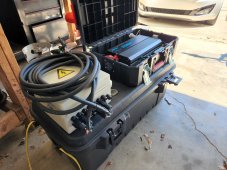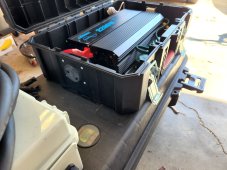Hi. Please excuse me if this post isn't in the right section, I have read around a bit trying to see if my question was answered directly and couldn't find out for certain.
I am building my first DIY solar system after owning an "all in one" portable unit (Jackery 1500) for a while.
I have two Harbor Freight 100W monocrystalline panels and one 100W amorphous (4x25w "kit") (can link if the forum approves), plus a splitter and adapter to charge my Jackery with. I would be using these panels for the DIY system as well.
Most of my usage would be 12V, but I would need to be able to use a small inverter on the system for a laptop that doesn't have a 12V DC power supply available for it.
I also have a 30amp charge controller, 10AWG wire, and a Renogy 100AH AGM battery.
For using the system, I have a set of terminal splitters to run two wires off each terminal (one input, one output), a small 120W inverter, and plan on purchasing a marine-style set of 12V outlets (can link to this as well).
My main question is how to safely put this system together when it comes to grounding it (or not) and fusing it. It doesn't seem safe to just connect everything and leave it floating.
I have never put together a DIY system and obviously the Jackery/portable unit is simple, just plug in the panel(s) and it charges, everything else is self-contained.
But as a person who's done other electrical work for a while, I am worried about how I put all this together, especially once an AC inverter is attached to the system. Nothing I've read has directly referenced a setup like mine even though it's probably a simple/stupid question.
I really like the portability of the Jackery all-in-one unit, and am trying to build something modular that can also be portable when I need it to be. I have a vehicle I travel and camp in that would be the primary usage spot for the system, but might also pull it out to use in a cabin for a short while, and would like to be able to set it up on a cart (like a tool cart, etc) in the event of a prolonged power outage in my area, so I can use it wherever when at home.
I plan on using 12V power for 90% of my usage if not more (such as lighting, fans, etc). It's mostly going to be a low-draw system except for a computer/laptop and box fan/ventilation fan. Everything else used would be low wattage, on purpose.
But I have a small 120W inverter which currently would be used for powering a laptop/computer first and foremost, and also possibly running a few low wattage AC devices (like charging power tool batteries as I don't yet have a 12V input charger for them). Down the road, I would like to have a better inverter, just for the added functionality, but right now, it is safe to assume that the inverter will only be used to power a laptop computer and a few random devices that don't have 12V input.
So the question is this: Do I just connect the panels to the charge controller, and then the controller to the battery with appropriate gauge wire, with no ground or earth anywhere, just black/black to red/red? Or will this not work for charging the battery with solar?
And then for the output of the system, would I simply connect the 12V outlet or device's positive lead to the positive battery terminal and negative lead to the negative terminal with the battery not grounded to anywhere? If I was running a set of cigarette lighter style outlets, for example, or a power inverter, would I just attached blk/blk and red/red and leave the system "floating"?
Because I'd like to put this system on a cart or something similar that can be rolled around, I don't know where I would ground it in that situation. In a vehicle, chassis ground is available, and in a cabin, it could be earthed with a ground rod? I want to make sure I'm doing this correctly for safety purposes. Can't afford shocks or fires.
Finally the question of where to place fuse(s) in such a setup is still a bit vague to me.
Thanks a lot for the help and I apologize in advance if this is a stupid/overthinking kind of question.
I am building my first DIY solar system after owning an "all in one" portable unit (Jackery 1500) for a while.
I have two Harbor Freight 100W monocrystalline panels and one 100W amorphous (4x25w "kit") (can link if the forum approves), plus a splitter and adapter to charge my Jackery with. I would be using these panels for the DIY system as well.
Most of my usage would be 12V, but I would need to be able to use a small inverter on the system for a laptop that doesn't have a 12V DC power supply available for it.
I also have a 30amp charge controller, 10AWG wire, and a Renogy 100AH AGM battery.
For using the system, I have a set of terminal splitters to run two wires off each terminal (one input, one output), a small 120W inverter, and plan on purchasing a marine-style set of 12V outlets (can link to this as well).
My main question is how to safely put this system together when it comes to grounding it (or not) and fusing it. It doesn't seem safe to just connect everything and leave it floating.
I have never put together a DIY system and obviously the Jackery/portable unit is simple, just plug in the panel(s) and it charges, everything else is self-contained.
But as a person who's done other electrical work for a while, I am worried about how I put all this together, especially once an AC inverter is attached to the system. Nothing I've read has directly referenced a setup like mine even though it's probably a simple/stupid question.
I really like the portability of the Jackery all-in-one unit, and am trying to build something modular that can also be portable when I need it to be. I have a vehicle I travel and camp in that would be the primary usage spot for the system, but might also pull it out to use in a cabin for a short while, and would like to be able to set it up on a cart (like a tool cart, etc) in the event of a prolonged power outage in my area, so I can use it wherever when at home.
I plan on using 12V power for 90% of my usage if not more (such as lighting, fans, etc). It's mostly going to be a low-draw system except for a computer/laptop and box fan/ventilation fan. Everything else used would be low wattage, on purpose.
But I have a small 120W inverter which currently would be used for powering a laptop/computer first and foremost, and also possibly running a few low wattage AC devices (like charging power tool batteries as I don't yet have a 12V input charger for them). Down the road, I would like to have a better inverter, just for the added functionality, but right now, it is safe to assume that the inverter will only be used to power a laptop computer and a few random devices that don't have 12V input.
So the question is this: Do I just connect the panels to the charge controller, and then the controller to the battery with appropriate gauge wire, with no ground or earth anywhere, just black/black to red/red? Or will this not work for charging the battery with solar?
And then for the output of the system, would I simply connect the 12V outlet or device's positive lead to the positive battery terminal and negative lead to the negative terminal with the battery not grounded to anywhere? If I was running a set of cigarette lighter style outlets, for example, or a power inverter, would I just attached blk/blk and red/red and leave the system "floating"?
Because I'd like to put this system on a cart or something similar that can be rolled around, I don't know where I would ground it in that situation. In a vehicle, chassis ground is available, and in a cabin, it could be earthed with a ground rod? I want to make sure I'm doing this correctly for safety purposes. Can't afford shocks or fires.
Finally the question of where to place fuse(s) in such a setup is still a bit vague to me.
Thanks a lot for the help and I apologize in advance if this is a stupid/overthinking kind of question.




